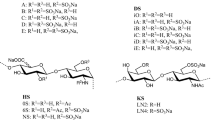Summary
The hydration of hyaluronic acid (HA) accumulated in the secondary palatal processes is expected to exert an intrinsic tissue pressure that could, in part, provide the impetus for shelf reorientation. Glycosaminoglycans were histochemically localized in the A/J mouse palate during development (days 12 to 15) by specific enzymatic degradation followed by preferential staining with alcian blue under differential pH or MgCl2 concentration. The presence of HA and chondroitin sulphates A and C (CS) was demonstrated in proportions that differed regionally. At the time of reorientation (days 14 to 15) HA was the predominant staining component, being distributed according to the relative prominence of extracellular spaces (ECS). HA was present in higher concentration in the anterior than the posterior part of the palate, particularly in an area of low cell density adjoining the CS-rich mesenchyme of the maxillary process. This arrangement suggests that the maxillary process might provide a resilient incompressible structural base for the palate as its HA-rich ECS expands. Sulphated GAG, with CS being the predominent component, was localized for the most part on the oral-side mesenchyme both in the anterior and posterior palate. The most intense staining of sulphated proteoglycans occurred in association with the basal lamina along the presumptive oral-side. Mesenchymal cells along this region appeared condensed and may have been stabilized by these sulphated GAG providing structural constraints which might function in palate morphogenesis.
Similar content being viewed by others
References
Babiarz BS, Allenspach AL, Zimmerman EF (1975) Ultrastructural evidence of contractile systems in mouse palates prior to rotation. Dev Biol 47:32–44
Babiarz BS, Wee EL, Zimmerman EF (1979) Palate morphogenesis III. Changes in cell shape and orientation during shelf elevation. Teratology 20:249–278
Baratz RS, Zenati NA (1979) The content of water, protein, DNA, RNA and sugar in fetal rat palate processes during reorientation and fusion. Arch Oral Biol 24: 607–611
Bolender DL, Seliger WG, Markwald RR (1980) A histochemical analysis of polyanionic compounds found in the extracellular matrix encountered by migrating cephalic neural crest cells. Anat Rec 196:401–412
Brinkley LL (1980) In vitro studies of palatal shelf elevation. In: Pratt RM, Christiansen RL, (eds) Current research trends in prenatal craniofacial development. Elsevier North Holland, New York, pp 203–220
Brinkley LL (1984) Changes in cell distribution during mouse secondary palate closure in vivo and in vitro I. Epithelial cells. Dev Biol 102:216–227
Brinkley LL, Vickerman MM (1979) Elevation of lesioned palate shelves in vitro. J Embryol Exp Morphol 54:229–240
Brinkley LL, Vickerman MM (1982) The effects of chlorcyclizine-induced alterations of glycosaminoglycans on mouse palatal shelf elevation in vivo and in vitro. J Embryol Exp Morphol 69:193–213
Bulleit RF, Zimmerman EF (1984) Role of the epithelium in secondary palate morphogenesis. Teratology 29: 21a
Bulleit, RF, Zimmerman, EF (1985) The influence of the epithelium on palate shelf reorientation. J Embryol Exp Morphol (in press)
Derby MA, Pintar JE (1978) The histochemical specificity ofStreptomyces hyaluronidase and chondroitinase ABC. Histochem J 10:529–547
Diewert VM, Tait B (1979) Palatal process movement in the rat as demonstrated in frozen sections. J Anat 128:609–618
Ferguson MWJ (1978) Palatal shelf elevation in the Wistar rat fetus. J Anat 125:555–577
Hassell JR, Orkin RW (1976) Synthesis and distribution of collagen in the rat palate shelf elevation. Dev Biol 49:80–88
Karovsky MJ (1965) A formaldehyde-glutaraldehyde fixative of high osmolarity for use in electron microscopiy. J Cell Biol 27:137A
Kuhn EM, Babiarz BS, Lessard JL, Zimmerman EF (1980) Palate morphogenesis I. Immunological and ultrastructural analysis of mouse palates. Teratology 21:209–223
Lev R, Spicer SS (1964) Specific staining of sulphate groups at low pH. J Histochem Gytochem 12:309
Ludowieg J, Vennesland B, Dorfman A (1961) The mechanism of action of hyaluronidases. J Biol Chem 236: 333–339
Luke DA (1984) Epithelial proliferation and development of rugae in relation to palate shelf elevation in the mouse. J Anat 138:251–258
Manasek FJ (1975) The extracellular matrix: a dynamic component of the developing embryo. Curr Top Dev Biol 10:35–102
O'Hare MJ (1973) A histochemical study of sulphated glycosaminoglycans associated with the somites of the chick embryo. J Embryol Exp Morphol 29:197–208
Pourtois M (1972) Morphogenesis of the primary and secondary palate. In: Slavkin HC, Bavetta LA eds. Developmental aspects of oral biology. Academic Press, New York, London, pp 81–108
Pratt RM, Jr, Goggins JF, Wilk AL, King CTG (1973) Acid mucopolysaccharide synthesis in the secondary palate of the developing rat at the time of rotation and fusion. Dev Biol 32:230–237
Pratt RM, Larsen MA, Johnson MC (1975) Migration of cranial neural crest cells in a cell-free hyaluronate-rich matrix. Dev Biol 44:298–305
Scott JE, Dorling J (1965) Differential staining of acid glycosaminoglycans (mucopolysaccharides) by alcian blue in salt solutions. Histochemistry 5:221–233
Shah RM (1979) A cellular mechanism for the palatal shelf reorientation from a vertical to a horizontal plane in hamster: a light and electron microscopy study. J Embryol Exp Morphol 53:1–13
Toole BP, Underhill CB, Mikuni-Takagaki Y, Orkin RW (1980) Hyaluronate in morphogenesis. In: Pratt RM, Christensen RL, ed, Current research trends in prenatal craniofacial development. Elsevier North Holland. New York, pp 263–275
Walker BE, Fraser CF (1956) Closure of the secondary palate in three strains of mice. J Embryol Exp Morphol 4:176–189
Wee EL, Zimmerman EF (1980) Palate morphogenesis II. Contraction of cytoplasmic processes in ATP-induced palate rotation in glycerinated mouse heads. Teratology 21:15–27
Yamada K (1973) The effect of digestion withStreptomyces hyaluronidase upon certain histochemical reactions of hyaluronate acid-containing tissues. J Histochem Cytochem 21: 794–803
Zimmerman EF, Wee EL (1984) Role of neurotransmitters in palate development. Curr Top Dev Biol 19:37–63
Author information
Authors and Affiliations
Rights and permissions
About this article
Cite this article
Knudsen, T.B., Bulleit, R.F. & Zimmerman, E.F. Histochemical localization of glycosaminoglycans during morphogenesis of the secondary palate in mice. Anat Embryol 173, 137–142 (1985). https://doi.org/10.1007/BF00707312
Accepted:
Issue Date:
DOI: https://doi.org/10.1007/BF00707312




